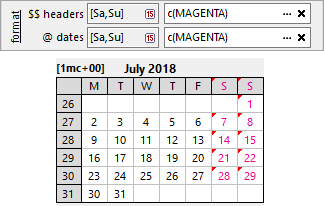The Weekday Header options, located at the top left of the Minicalendar properties dialog, let you specify the manner in which the the $$ elements of MiniCalendar tokens are converted and displayed.
char #

The using token option lets you choose from which token translation ([ddd] or [dddd]) to obtain char # characters in the preceding option.
For English and many other languages, the value of the first 3 letters of the tokens [ddd] and [dddd] are usually the same, so this option has no impact. However in some languages such as Catalan, Polish and Russian, this is not the case, and this option needs to be set to [ddd] rather than the default of [dddd].
Caps
The Caps option controls the capitalization of the weekday at the top of the MiniCalendar. Setting this option to First will capitalize only the first letter (ie. M, Mo, Mon for char # values of 1, 2, and 3). Setting this option to All will capitalize the entire weekdays. Note that setting this option to None will not change the capitalization. This is not the same as making the weekdays all lowercase, since the translation of the weekday token [dddd] in the Tokens Manager may have been set to always start with a capital letter, which is the case in German.
Current Date $$

Similarly, the $$ headers and the @ dates settings let you specify that the $$ and @ tokens should be displayed using a special formatting for certain weekdays, as well as when they correspond to holidays or holidays or the current week or the current spread (although, here again, the use of these settings for holidays or the current week or the current spread, only makes sense for one-line minicalendars, where there are as many $$ tokens as there are possible days).
In the example on the right, the Saturdays and Sundays are set to be in magenta.
Topic 143400, last updated on 26-Jun-2025